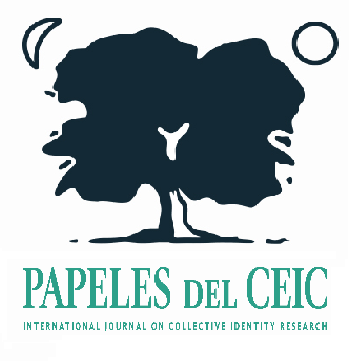At Home. Traces of Precarious Habitation
##plugins.themes.bootstrap3.article.main##
##plugins.themes.bootstrap3.article.sidebar##
Abstract
This article looks at the meanings that men and women in situations of homelessness —subjected to an urbanity on edge in various communes in the Paris region— give to their living spaces. These meanings emerge from a series of scenes and ethnographic accounts of living practices and social interactions shared by these people. These stories of active lives highlight the interpretative and ethically questionable violence contained in the equation applied to the analysis of the daily experiences of these same people, which establishes a causal relationship between extreme socio-economic insecurity and an inability to take part in this world. An equation that reduces them to desocialised beings, incapable of building their own place, a home, where they can preserve their intimacy, organize their daily lives and at the same time open to others in a gesture of welcome and exchange. These stories of memories and homes, experiences, knowledge, and know-how reveal, in contrast to the de-socialising view, people carrying out a relentless daily struggle to confront the historical and structural determinants of their extreme living conditions, a struggle that makes them an inescapable and vital part of our common social world.
How to Cite
##plugins.themes.bootstrap3.article.details##
home, homeless people, memory, biographical refuges, reflexive ethnography
Arendt, H. (1988). Condition de l'homme moderne. Paris: Pocket.
Capranzano, V. (1994). Reflexions sur une anthropologie des émotions. Terrain, 22, 109-117.
Devereux, G. (1990). De l’angoisse à la méthode dans les sciences du comportement. Paris: Flammarion.
Favret-Saada, J. (1990). Être affecté. Gradhiva, 8, 3-9.
Faure, A., y Rancière, J. (1976). La parole ouvrière. Paris: Union générale d’éditions.
Girola, C. (2011a). De l’homme liminaire à la personne sociale. La lutte quotidienne des sans-abri. Lille: ARNT.
Girola, C. (2011b). Vivre sans abri. De la mémoire des lieux à l’affirmation de soi. Paris: Editions rue d’Ulm.
Girola, C. (2016). Les personnes sans abri dans un monde commun, choc de la ressemblance, apparition réciproque et réflexivité. En C. Girola, P. Pichon y E. Jouve (Dirs.), Au temps du sans abrisme. Enquête de terrain et problème public (pp. 171-181). Saint Etienne: PUSE.
Girola, C. (2017). Y sin embargo las personas sin techo siguen ahí… Fronteras en los fundamentos del espacio público. En E. Rinesi, J. Smola y L. Eiff (Comps.), Las diagonales del conflicto. Política y Sociedad en Argentina y Francia (pp. 239-250). Buenos Aires: Ediciones UNGS.
Huberman, G. D. (1998). Phasmes. Essais sur l’apparition. Paris: Les Editions de Minuit
Huberman, G. D. (2003). Images malgré tout. Paris: Minuit.
Levinas, E. (1971). Totalité et infini. Essai sur l’extériorité. Paris: Kluwer academic.
Mallarmé, S. (1945). Igitur ou la folie d’Elbehnon (1869), Œuvres complètes. Paris : Gallimard.
Mathieu, N.-C. (1985). Quand céder n’est pas consentir. En L’Arraisonnement des femmes. Essai en anthropologie des sexes (pp. 169-243). Paris: Editions de l’EHESS.
Perec, G. (2022). Espèces d’espaces. Paris: Seuil.

This work is licensed under a Creative Commons Attribution-NonCommercial-NoDerivatives 4.0 International License.
Papeles del CEIC is distributed under the licence Creative Commons Reconocimiento-NoComercial-SinObraDerivada 3.0 España (CC BY-NC-ND 3.0 ES)
Usted es libre de:
- copiar, distribuir y comunicar públicamente la obra
Bajo las condiciones siguientes:
- Reconocimiento — Debe reconocer los créditos de la obra de la manera especificada por el autor o el licenciador (pero no de una manera que sugiera que tiene su apoyo o apoyan el uso que hace de su obra).
- No comercial — No puede utilizar esta obra para fines comerciales.
- Sin obras derivadas — No se puede alterar, transformar o generar una obra derivada a partir de esta obra.
Entendiendo que:
- Renuncia — Alguna de estas condiciones puede no aplicarse si se obtiene el permiso del titular de los derechos de autor
- Dominio Público — Cuando la obra o alguno de sus elementos se halle en el dominio público según la ley vigente aplicable, esta situación no quedará afectada por la licencia.
- Otros derechos — Los derechos siguientes no quedan afectados por la licencia de ninguna manera:
- Los derechos derivados de usos legítimos u otras limitaciones reconocidas por ley no se ven afectados por lo anterior.
- Los derechos morales del autor;
- Derechos que pueden ostentar otras personas sobre la propia obra o su uso, como por ejemplo derechos de imagen o de privacidad.
- Aviso — Al reutilizar o distribuir la obra, tiene que dejar bien claro los términos de la licencia de esta obra.
The author can use his/her article freely always indicating that it has been published in Papeles del CEIC. International Journal on Collective Identity Research. Any re-edition of the article must be approved by the journal editorial team.

